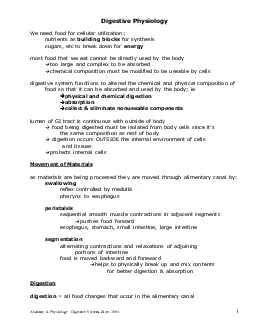

pharynx to esophagus all food changes that occur in the alimentary canalAnatomy Physiology Digestive System Ziser 2003breaking large molecules proteins fats starches etca thick coating of bicarbona ID: 885270
Download Pdf The PPT/PDF document "Anatomy Physiology Digestive System Zi..." is the property of its rightful owner. Permission is granted to download and print the materials on this web site for personal, non-commercial use only, and to display it on your personal computer provided you do not modify the materials and that you retain all copyright notices contained in the materials. By downloading content from our website, you accept the terms of this agreement.
1 Anatomy & Physiology: Digestive System,
Anatomy & Physiology: Digestive System, Ziser, 2003the same composition as rest of body pharynx to esophagus = all food changes that occur in the alimentary canal Anatomy & Physiology: Digestive System, Ziser, 2003bre
2 aking large molecules (proteins, fats, s
aking large molecules (proteins, fats, starches, etc)a. thick coating of bicarbonate rich mucousb. tight junctions join epithelial cells to help prevent leakagec. stomach lining is rapidly replacedd. pepsin and HCl
3 are secreted in inactive forms Anatomy &
are secreted in inactive forms Anatomy & Physiology: Digestive System, Ziser, 2003also produces its own set of enzymespresence of chyme in duodenum triggers: Anatomy & Physiology: Digestive System, Ziser, 2003 1. Sal
4 iva learned by association: eg. Pavlov
iva learned by association: eg. Pavlovs dogthoughts of food Anatomy & Physiology: Digestive System, Ziser, 2003stimulates parietal cells to secrete hormone = gastrin circulates within capillaries of stomach andstretc
5 h receptorsshuts down gastric secretions
h receptorsshuts down gastric secretionssecretes cholecystokininstimulates peristalsis of gall bladder Anatomy & Physiology: Digestive System, Ziser, 2003 absorption occurs throughout digestive tractreclaims some addit
6 ional bile saltsMost nutrient absorption
ional bile saltsMost nutrient absorption occurs in the small intestine1. epithelial cells are joined by Anatomy & Physiology: Digestive System, Ziser, 2003is greatly increased for more efficient absorption ofa. 1 d
7 iameter x 10 longb. but: interior is f
iameter x 10 longb. but: interior is foldedc. also: fingerlike projections = d. also: each epithelial cell of villus has microvilli essentially some kind of membrane transport1. most nutrients are absorbed by 2.
8 some lipids are absorbed by to lactealse
some lipids are absorbed by to lactealseg.fats3. water is absorbed by 4. large molecules are absorbed by eg. a few large fats and Anatomy & Physiology: Digestive System, Ziser, 2003but more common in newbornswith ce
9 ll surface Anatomy & Physiology: Digest
ll surface Anatomy & Physiology: Digestive System, Ziser, 2003a. water soluble vitaminsb. fat soluble mainly in duodenumamount absorbedstored until needed or lost as cells sloughed off Anatomy & Physiology: Digestiv
10 e System, Ziser, 2003absorption in intes
e System, Ziser, 2003absorption in intestine~150 ml of feces is produced Anatomy & Physiology: Digestive System, Ziser, 2003 2. 3. releases nutrients (eg glucose) to maintain blood levels4. phagocytes remove old/dam
11 aged blood cells and pathogens6. is lar
aged blood cells and pathogens6. is largest 7. collects and removes metabolic wastes such as cholesterol, products8. secrete bile to aid in digestion (~1pt /day)brings oxygen to liver cellsa. phagocytic cells remove
12 toxic compoundsb. some vitamins and nu
toxic compoundsb. some vitamins and nutrients are removed and storedc. synthesis of starches, lipids and proteins for storaged. cholesterol, bile pigments and bile salts are secreted Anatomy & Physiology: Digestive
13 System, Ziser, 2003Hepatic ArteryHepati
System, Ziser, 2003Hepatic ArteryHepatic VeinalHepatic Bile Ducts jaundice = bile ducts obstructed their secretions pass into circulatory system removes toxins stores vitamins Anatomy & Physiology: Di
14 gestive System, Ziser, 2003DONT hit on
gestive System, Ziser, 2003DONT hit on backif severe may empty duodenum as wellside effect of medication Anatomy & Physiology: Digestive System, Ziser, 2003cure: eat 10. Ulcersdiet therapy used to be main cure, now